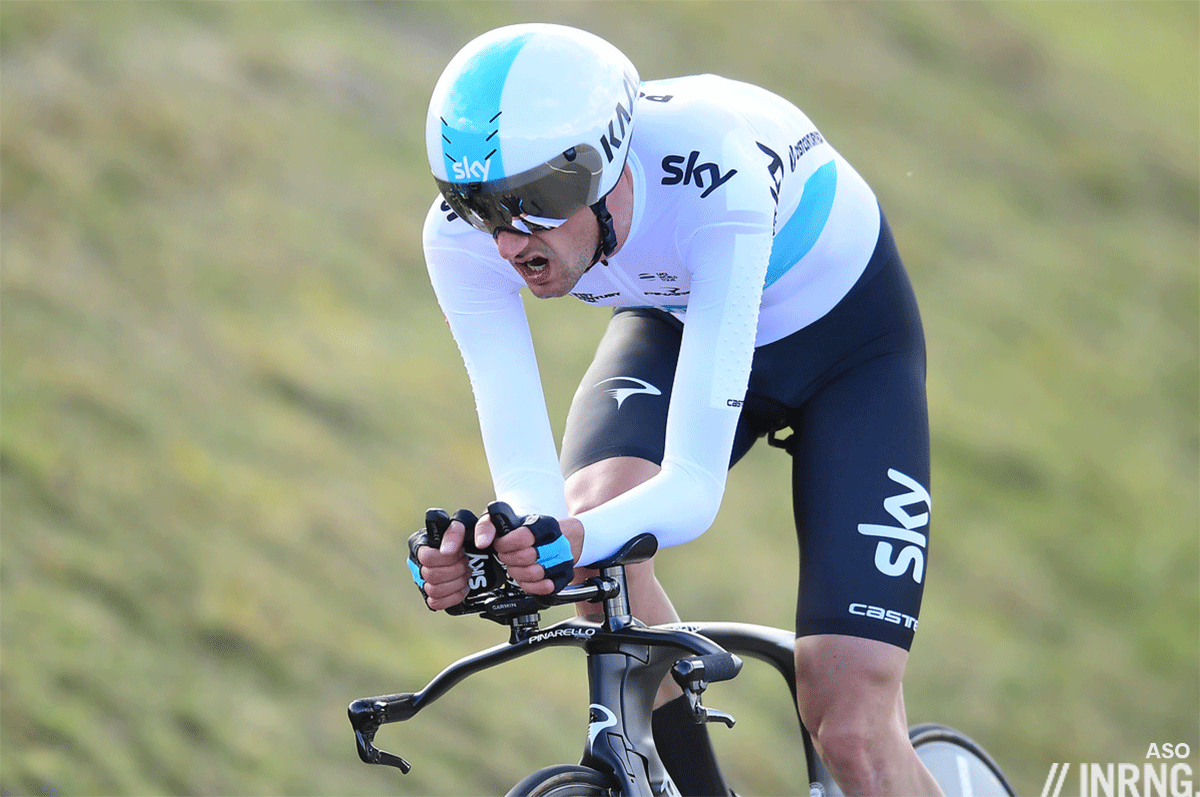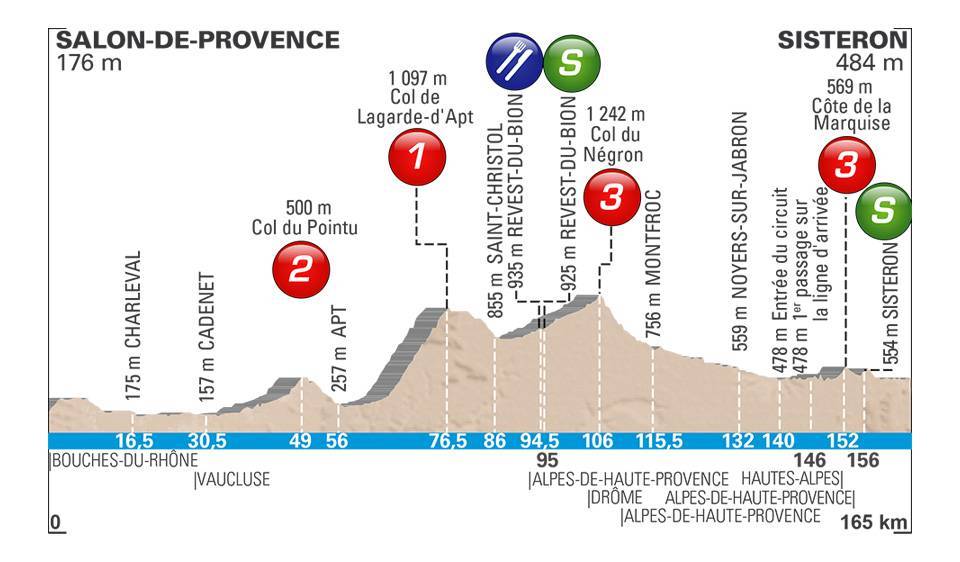A good day for a breakaway with a hilly course around Provence and the Alpine foothills.

Stage 4 Wrap: a win for Wout Poels ahead of Marc Soler and Julian Alaphilippe. It rained during the race which made the course sketchy for some but the late finishers still set the fastest times and Luis-Leon Sanchez kept his yellow jersey and got another lion. Felix Großschartner confirmed his good riding with a top-10 and Esteban Chaves was an impressive tenth. The likes of Tony Gallopin, Ilnur Zakarin and Bauke Mollema rode themselves out of contention.
The Route: 165km and north for a change, the race starts in Provence and heads into the Alps. The Col du Pointu (“Pointy pass”) isn’t as steep as it sounds, 4km at 5% and no surprises. The Col de Lagarde d’Apt might be a finish line for a few riders because it’s a first category climb and a “win” at the top should bring them the mountains jersey. It’s a long climb of 11km at a steady 7% and leads to the Albion plateau. The Col du Négron is listed at 5.9km at 3% in the roadbook but the climb is longer and there’s a brief 10% section before the “official” climb starts. From here there’s 60km to go via Montfroc down the Jabron valley, or at least mainly down, the road rises and falls on the way to Sisteron.
The Finish: they ride into Sisteron – a habitual scenic stop for this race – and then head out for the small climb of the Côte de la Marquise which is 1.3km at 6.7%. It should be familiar to some as it was climbed in the 2015 Critérium du Dauphiné and proved to be a hectic finale when Tim Wellens attacked but it came back together for a bunch sprint won by Nacer Bouhanni in his pomp. The descent is gentler than the climb and on wider roads but still fast as it heads out of town for a loop before turning back up the valley road for 3km and a flat finish.
The Contenders: breakaway or sprint? There are almost 100 riders four minutes or more down on GC meaning they’ve got room to manoeuvre, a breakaway seems most likely. However several teams have sprinters in the race and no stage win and the finish is not too hard they have an incentive to set up their sprinter for the finish.
For the breakaway will we see any of the classics contenders test themselves? One school of thought says having a go is part of the preparation, another is you sit tight all week and just bank the distance. Picks include Oliver Naesen (Ag2r La Mondiale), Yves Lampaert (Quick Step), Edward Theuns (Sunweb), Jürgen Roelandts (BMC Racing) and Ivan Garcia Cortina (Bahrain-Merida) while Ian Stannard and Michael Valgren are likely to be retained on team duties.
For the sprinters the final climb is hard work and if Nacer Bouhanni won in 2015 this was in the summer when many more riders have their climbing legs. Still a test for Dylan Groenwegen, Arnaud Démare is in good shape and the likes of Matteo Trentin and Magnus Cort Nielsen get the nod again.
| – | |
| Arnaud Démare, |
|
| Trentin, Cort Nielsen, Naesen, Theuns, Garcia Cortina |
Weather: cloudy and a top temperature of 13°C. We’re in mistral country, the area is blasted by this wind for over one hundred days a year but calm conditions are forecast.
TV: You should find it on the same channel as you watch the Tour de France. It’s on Eurosport and you can rely on Cyclingfans and steephill.tv for links to feeds and streams. The finish is later than usual, a predicted 5.10pm.


Lilian Calmejane.
I see you and raise you a Thomas De Gendt 😉
It is always fun wen a race goes over your local climb and today it is Lagarde d’Apt The climb is fairly regular with about 4 hairpins which ramp up to 11%. The road surface is typical of the region and smooth, but drags on your wheels. The weather is not exactly Provencal and the temperature by my front door is currently 6 degrees with a few clouds the sky. The wind we have had over the past few days has dropped – for the moment. The climb leads onto the Plateau d’Albion where the road becomes suspiciously wide and well surfaced. This is because he ground-based component of the French nuclear deterrent was located on the Plateau d’Albion in the Cold War. Because of the low population density and subsoil suitable for anchoring the underground missile silos and withstanding the shock wave in the event of a nuclear attack. Eighteen underground missile silos (launch facilities) and two missile launch control centres were built between 1966 and 1971. The facilities were shutdown in 1997. The last missile stages were removed in December 1997, and the last nuclear warhead in February 1998. One of the former launch sites is now a Michelin starred restaurant. All that aside it is a great region to ride a bike.
This is great local inside knowledge and genuinely interesting.
+1
Enjoy the day, a pity you won’t see your local roads on TV as everything seems to look better when filmed from the sky.
Often as interesting as the articles and previews on this site are the comments. Now off to find my old French history books to read with the race on in the background 🙂
Also if anyone’s on twitter Kevin often posts about cycling in the mountains (although a lot of politics issues too), see https://twitter.com/kevingunning
Thanks for the mention – its only two political issues really, not surprisingly given my background and where I now live – the NHS and Brexit!
Good read.
Throw in some music and you’ve got a winner 🙂
Thanks, very interesting.
Thanks very much Kevin, brilliant insight! Can’t get facts like this anywhere else. And as ever thank you Mr Inrng 🙂
Thomas of Ghent; unless he spent too much time in the pub last night.
Why is Dylan Groenwegen crossed out?
I think it’s because it’ll be too hilly for him so he doesn’t really have a chance.
INRNG is there any chance for someone like wellens or alaphillipe to attack and perhaps win or is it too long to the finish. I wasn’t watching cycling at that time so I haven’t seen how close he was back then?
There’s a chance for the attack but someone like Wellens or Alaphilippe will be heavily marked and chased. The flat roads to the finish make it hard for a late attack, take 20 seconds on the climb, hold it on the descent but maintaining this on the way to the finish is not easy. Worth trying, easier said than done.
He’s DNS today, as well as team mate Lars Boom.
Groenewegen and Lars Boom are out because they have a cold.
https://nos.nl/artikel/2221198-verkoudheid-velt-nederlands-duo-in-parijs-nice.html
Totally off-topic, but look at the last picture in this article:
https://cyclingtips.com/2018/03/living-dangerously-outsiders-perspective-cycling-india/
An INRNG-jersey spotted in the Himalayas!
Wow, thanks for sharing. It’s not just anywhere in the Himalayas either, it’s the top of Khardung La which is supposed to be the highest road pass in the world.
Does that mean you’ve now officially made it to the top? :o)
I love your prose INRG, but please don’t use ‘in his pomp’. It reminds me of Carlton Kirby.😱
Thanks everyone,
Nice to back in racing season with eclectic info and local provenance.